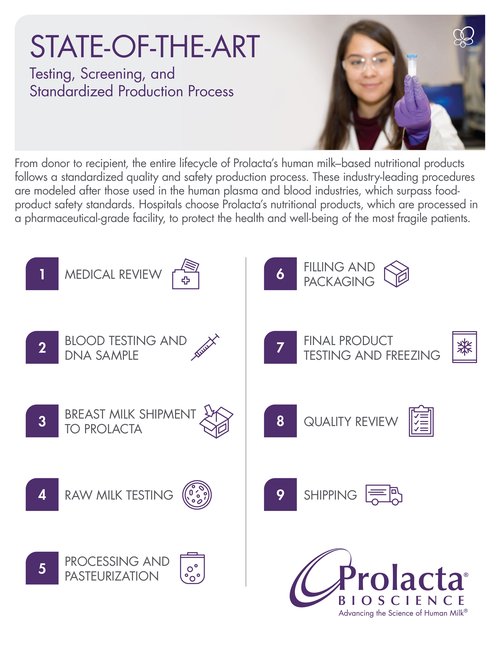
STATE-OF-THE-ART
Testing, Screening, and Standardized Production Process
From donor to recipient, the entire lifecycle of Prolacta’s human milk–based nutritional products
follows a standardized quality and safety production process. These industry-leading procedures
are modeled after those used in the human plasma and blood industries, which surpass food product
safety standards. Hospitals choose Prolacta’s nutritional products, which are processed in
a pharmaceutical-grade facility, to protect the health and well-being of the most fragile patients.
1 MEDICAL REVIEW
- Donor undergoes medical and social screening
- Donor must produce milk in excess of what her baby needs and provide written Confirmation of Health from her doctor and her baby’s pediatrician
2 BLOOD TESTING AND DNA SAMPLE
- Donor is tested for HIV-1 & 2, HTLV-I & II, HBV, HCV, and syphilis
- DNA sample is taken to create a genetic ID for the sole purpose of verifying the breast milk comes from that qualified donor
3 BREAST MILK SHIPMENT TO PROLACTA
- Donor’s freezer temperature is verified
- Donor is supplied with storage bags, freezer bricks, an insulated cooler, and a prepaid shipping label
- Donor ships frozen breast milk to Prolacta
4 RAW MILK TESTING
- Prolacta developed, validated, and implemented more than 20 tests for screening raw milk to ensure quality and safety
- DNA matching is performed for assured donor identification; raw milk is visually inspected and tested for Bacillus cereus (B. cereus), adulteration, nicotine, and drugs of abuse
- Raw milk is directly tested using a nucleic acid amplification test (NAAT) for disease-causing pathogens, including:
— Human immunodeficiency virus type 1 and type 2 (HIV-1, HIV-2)
— Human T-cell lymphotropic virus type I and type II (HTLV-I, HTLV-II)
— Hepatitis virus B and C (HBV, HCV)
— SARS-CoV-2 (COVID-19)
— Zika virus (ZIKV)
— Treponema pallidum (syphilis)
— Mycobacterium tuberculosis (TB)
5 PROCESSING AND PASTEURIZATION
- Microbiological testing is done at multiple points in the process
- Donor breast milk is formulated into fortifier or standardized human milk products, then pasteurized with a vat method following time and temperature profiles defined by the U.S. Food and Drug Administration (FDA) in its Pasteurized Milk Ordinance (PMO)
- Prolacta’s vat pasteurization—a process similar to Holder pasteurization1,2—effectively destroys pathogenic bacteria while retaining high levels of product nutrients
- Nutritional products manufactured with Prolacta’s processes preserve the bioactivity of human milk and are clinically proven to improve health outcomes for premature infants when used as part of an exclusive human milk diet in the neonatal intensive care unit3,4,5,6,7
6 FILLING AND PACKAGING
- Product is filled into high-density polyethylene bottles (BPA free)
- Product is labeled with nutritional values, “use by” date, and product lot number
- Color-specific labeling also provides instructions for safe storage, mixing, and administration
7 FINAL PRODUCT TESTING AND FREEZING
- Microbiological screening is conducted, including aerobic count, B. cereus, Escherichia coli/coliform, Salmonella, Pseudomonas aeruginosa, Staphylococcus aureus, yeast, and mold
- B. cereus emetic toxin analysis is performed
- Nutritional analysis is performed
- Product is frozen for storage
8 QUALITY REVIEW
- Product is not released until all data are reviewed, verified, and approved by Quality Assurance
- Final verification is performed against product specifications to assure product quality
9 SHIPPING
- Order is verified to ensure the accurate number of products are packaged
- Frozen products are shipped in insulated coolers with dry ice
- Products are closely tracked until arrival at hospitals
- Coolers are returned to Prolacta, cleaned, and reused to minimize waste
1 Meredith-Dennis L, Xu G, Goonatilleke E, Lebrilla CB, Underwood MA, Smilowitz JT. Composition and variation of macronutrients, immune proteins, and human milk oligosaccharides in human milk from nonprofit and commercial milk banks. J Hum Lact. 2018;34(1):120-129. doi:10.1177/0890334417710635
2 Lima HK, Wagner-Gillespie M, Perrin MT, Fogleman AD. Bacteria and bioactivity in Holder pasteurized and shelf-stable human milk products. Curr Dev Nutr. 2017;1(8):e001438. doi:10.3945/cdn.117.001438
3 Sullivan S, Schanler RJ, Kim JH, et al. An exclusively human milk-based diet is associated with a lower rate of necrotizing enterocolitis than a diet of human milk and bovine milk-based products. J Pediatr. 2010;156(4):562-567.e1. doi:10.1016/j. jpeds.2009.10.040
4 Cristofalo EA, Schanler RJ, Blanco CL, et al. Randomized trial of exclusive human milk versus preterm formula diets in extremely premature infants. J Pediatr. 2013;163(6):1592-1595.e1. doi:10.1016/j.jpeds.2013.07.011
5 Abrams SA, Schanler RJ, Lee ML, Rechtman DJ. Greater mortality and morbidity in extremely preterm infants fed a diet containing cow milk protein products. Breastfeed Med. 2014;9(6):281-285. doi:10.1089/bfm.2014.0024
6 Hair AB, Peluso AM, Hawthorne KM, et al. Beyond necrotizing enterocolitis prevention: improving outcomes with an exclusive human milk-based diet [published correction appears in Breastfeed Med. 2017;12(10):663]. Breastfeed Med. 2016;11(2):70-74. doi:10.1089/bfm.2015.0134
7 Assad M, Elliott MJ, Abraham JH. Decreased cost and improved feeding tolerance in VLBW infants fed an exclusive human milk diet. J Perinatol. 2016;36(3):216-220. doi:10.1038/jp.2015.1
